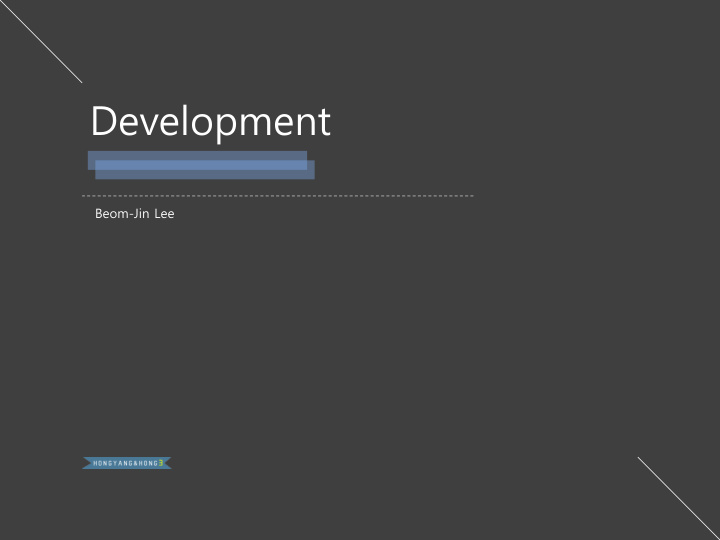



Development Beom-Jin Lee
This Chapter Covers The development of event cognition on children and older adults
Being Young Neurophysiological Changes • – basic visual and auditory processing stabilize shortly after birth – Much of the brainstem and midbrain is well developed and some of the medial temporal lobe machinery that is important for memory is well along the way. – In contrast, some parts of the cerebral cortex develop over a protracted time course. – (Huttenlocher, 1990) visual cortex reaches its adult volume and maximum synaptic density around the first year of life , prefrontal not stabilize until late teens – (Casey et al., 2000) with the development of the ability to maintain and manipulate information in working memory and with the development of inhibitory control over behavior and thinking, frontal lobes is protracted
Being Young Developmental Progression • – Processing of event-specific information – Around 2 months ∙ (Bourg et al. 1997) infants, “ micro-event ” capturing basic temporal relations ∙ (Baillargeon, 1986, 1987; Baillargeon, Spelke, & Wasserman, 1985) infants are creating event models of the circumstances - surprised when objects disappear or when they to fail to exert influences on other objects
Being Young – Around 11~20 months ∙ Conceiving events as actions sequences ∙ (Bourg et al. 1997) strings of two or more actions linked by temporal, causal, goal association ∙ (Nelson & Gruendel, 1986) Creating, elaborating on the scripts and schemas ∙ (Hudson, 1988) thus above aspects produces developmental change in event memory – preschool year ~ adulthood ∙ Begin creating autobiographical memories ∙ (Nelson & Fivush, 2004) goal directed understanding of the events in life ∙ Understand fictional events ∙ final level of the developmental progression of event comprehension and memory, children can derive more global thematic elements
Development of event cognition in terms Event Horizon Model Segmentation of Events • – segment the speech stream to learn words – segment the stream of activity to learn the meaningful units – (Baldwin & Baird, 1999) Predicting intentions from movements help infants learn goals, plans of caregiver and others – Infants individuate motion events similarly to adults ∙ (Wynn 1996) six months infants, whether puppet jumped twice or three times ∙ (Baldwin, et al. 2001) infants segmented events into units that corresponded to simple intentional actions - 1.5-s pauses on boundary or in- between(looked longer)
Development of event cognition in terms Event Horizon Model ∙ (Saylor, et al. 2007) infants prefer looking ∙ at visual displays that are synchronized with auditory events – infants use statistical occurrence information to segment naturalistic events ∙ (Saffran, 2003) learn the segments that occur in streams of language ∙ (Saffran, Johnson, Aslin & Newport, 1999) auditory tones ∙ (Fiser & Aslin, 2002) visual features that co-occur in scenes
The Construction of Working Models No studies directly investigating • Event model updating depends on the lateral prefrontal • cortex , but slow mature From (e.g., Bowen & Howie, 2002; Butler & Rovee-Collier, • 1989; La Rooy, Pipe, & Murray, 2007; Levy-Gigi & Vakil, 2010; Pipe & Wilson, 1994) - infants and children are able to use the context in which information was originally learned as an effective retrieval cue for what was learned in that context
The Causal Network (Arterberry, 1997; Bauer & Wewerka, 1997) Children are • sensitive to causal event structure and that this matures with age Ex) (Trabasso & Nickels, 1992; Trabasso & Stein, 1997) • narrate a story similar to adult when age 9
The Causal Network
The Causal Network Key player in autobiographical memory • Causal Network -> autobiographical memory -> • characteristics (Chen, McAnally, Wang, and Reese 2012) children who • better understand the experiences of their lives may also better understand their role in the larger society .
Noncompetitive Attribute Retrieval Noncompetitive Attribute Retrieval (Burt et al., 1995) Children are using the elements • distributed across events in ways to effectively cue the retrieval of specific event models (Bauer and Wewerka 1997) 2 year old better recall • information with objects, activities, or locations
Competitive Event Retrieval (Gómez-Ariza and Bajo 2003) 11 ~ 12 year-old children • showed fan effects similar to those of adults
Summary • There are clear developmental progressions made in children as they engage in event cognition . • The basic mechanisms of event segmentation and event model construction appear to be present early in life, guided by early-emerging core knowledge . • Event models become richer and more elaborated due to maturation and increases in event knowledge . • The role of event models in long-term memory retrieval is less well understood.
Thank You
Recommend
More recommend